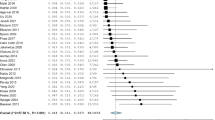Abstract
Background
The impact of submandibular gland (SMG) preservation during neck dissection on the survival of patients with early-stage oral squamous-cell carcinoma (OSCC) remains undocumented.
Methods
The medical records of all patients with early-stage OSCC (stage I and II) who underwent wide excision of the primary tumor and simultaneous neck dissection between 1999 and 2006 at our facility were retrospectively reviewed.
Results
We analyzed 408 patients, including 33 patients with and 375 patients without SMG preservation. The 5-year disease-free and overall survival rates were 78.8% and 90.9% for the patients with SMG preservation and 75.4% and 90.4% for the patients without SMG preservation, and these differences were not statistically significant (P = 0.79, P = 0.99, respectively). Similar survival rates between patients with and without SMG preservation were observed in those with oral tongue squamous-cell carcinoma (SCC) and with buccal SCC. Patients with T2 OSCC with SMG preservation had significantly lower 5-year disease-free survival rate than those without SMG preservation (P = 0.02), but overall survival rates were similar between these two groups.
Conclusions
Preservation of the SMG during neck dissection may be oncologically safe in patients with T1 OSCC, but the feasibility of SMG preservation seems less clear for T2 OSCC.



Similar content being viewed by others
References
Shingaki S, Takada M, Sasai K, et al. Impact of lymph node metastasis on the pattern of failure and survival in oral carcinomas. Am J Surg. 2003;185:278–84.
Shah JP. Patterns of cervical lymph node metastasis from squamous carcinomas of the upper aerodigestive tract. Am J Surg. 1990;160:405–9.
Chen TC, Wang CT, Ko JY, et al. Postoperative radiotherapy for primary early oral tongue cancer with pathologic N1 neck. Head Neck. 2010;32:555–61.
Iype EM, Sebastian P, Mathew A, et al. The role of selective neck dissection (I–III) in the treatment of node negative (N0) neck in oral cancer. Oral Oncol. 2008;44:1134–8.
Cunning DM, Lipke N, Wax MK. Significance of unilateral submandibular gland excision on salivary flow in noncancer patients. Laryngoscope. 1998;108:812–5.
Jacob RF, Weber RS, King GE. Whole salivary flow rates following submandibular gland resection. Head Neck. 1996;18:242–7.
Saarilahti K, Kouri M, Collan J, et al. Sparing of the submandibular glands by intensity modulated radiotherapy in the treatment of head and neck cancer. Radiother Oncol. 2006;78:270–5.
Chen TC, Lo WC, Ko JY, et al. Rare involvement of submandibular gland by oral squamous cell carcinoma. Head Neck. 2009;31:877–81.
Byeon HK, Lim YC, Koo BS, Choi EC. Metastasis to the submandibular gland in oral cavity squamous cell carcinomas: pathologic analysis. Acta Otolaryngol. 2009;129:96–100.
Razfar A, Walvekar RR, Melkane A, Johnson JT, Myers EN. Incidence and patterns of regional metastasis in early oral squamous cell cancers: feasibility of submandibular gland preservation. Head Neck. 2009;31:1619–23.
American Joint Committee on Cancer (AJCC). Manual for Staging of Cancer. New York: Springer-Verlag; 2002.
Fox PC, van der Ven PF, Sonies BC, Weiffenbach JM, Baum BJ. Xerostomia: evaluation of a symptom with increasing significance. J Am Dent Assoc. 1985;110:519–25.
Murdoch-Kinch CA, Kim HM, Vineberg KA, Ship JA, Eisbruch A. Dose-effect relationships for the submandibular salivary glands and implications for their sparing by intensity modulated radiotherapy. Int J Radiat Oncol Biol Phys. 2008;72:373–82.
Jha N, Seikaly H, Harris J, et al. Phase III randomized study: oral pilocarpine versus submandibular salivary gland transfer protocol for the management of radiation-induced xerostomia. Head Neck. 2009;31:234–43.
Jaguar GC, Lima EN, Kowalski LP, et al. Impact of submandibular gland excision on salivary gland function in head and neck cancer patients. Oral Oncol. 2010;46:349–54.
Berini-Aytes L, Gay-Escoda C. Morbidity associated with removal of the submandibular gland. J Craniomaxillofac Surg. 1992;20:216–9.
Acknowledgment
This work was supported in part by the National Science Council of the Republic of China (NSC 98-2314-B-002-046-MY3) and in part by the National Taiwan University Hospital (NTUH.98-M1238). We thank the staff of the Eighth Core Lab, Department of Medical Research, National Taiwan University Hospital for technical support during the study.
Conflicts of interest
None.
Author information
Authors and Affiliations
Corresponding author
Rights and permissions
About this article
Cite this article
Chen, TC., Lou, PJ., Ko, JY. et al. Feasibility of Preservation of the Submandibular Gland During Neck Dissection in Patients With Early-Stage Oral Cancer. Ann Surg Oncol 18, 497–504 (2011). https://doi.org/10.1245/s10434-010-1294-7
Received:
Published:
Issue Date:
DOI: https://doi.org/10.1245/s10434-010-1294-7




